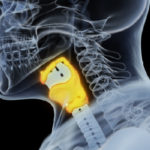What is stage 0 throat cancer?
Stage 0 throat cancer can be used to refer to either stage 0 hypopharyngeal or stage 0 oropharyngeal cancer. These are the scenarios where the cancerous tumor has not breached the epithelial or upper cell lining. These cancers do not spread to the lymph nodes, and cancer has not metastasized to any distant parts of the body.
Stage 0 throat cancer in terms of TNM staging (Tis | N0 | M0)
Throat cancer is staged according to the TNM system, developed by the American Joint Committee on Cancer (AJCC). TNM staging principles are based on the following three factors:
- T – This represents the size of the main tumor, and indicates how far the tumor has grown inside the throat and in nearby tissue areas.
- N – This represents cancer’s extent of spread into nearby lymph nodes, and determines the number and size of the affected lymph nodes.
- M – This represents the status of metastasis (spread) to distant organs in the body (commonly: the lungs, liver or bones)
Once the T, N and M aspects of the disease have been established via the right diagnostic systems for throat cancer, the information is consolidated to stage hypopharyngeal cancer that a specific patient exhibits. This is called the clinical stage of the disease.
Tis (In situ tumor) explained
In stage 0 throat cancer, the tumor is limited to the top layer of the cellular lining of the hypopharynx or the oropharynx. The tumor has not grown any deeper inside the throat (Tis).
Other cases where throat cancer is considered to be at stage 0
- Tx – When a doctor is unable to assess the size of the primary tumor
- T0 – When a doctor is unable to locate the primary tumor (unable to spot the exact location)
N0 + M0
In stage 0 throat cancer, there is no lymph node involvement and there are no signs of regional or distant metastasis.
In cases of stage 0 throat cancer, the disease is limited to the presence of precancerous or premalignant lesions and can be treated well with early intervention.




